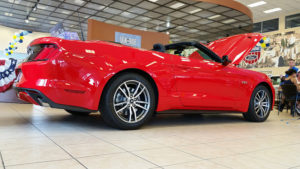 I have always been intrigued by and partially scared of the level of thought that goes into a car dealership’s sales plan. Everything from the phrases salespeople use to the layout of the showroom is all designed to promote selling. Recently I was waiting at the local dealership for my annual inspection when I started thinking about the layout of the shop waiting room.
I have always been intrigued by and partially scared of the level of thought that goes into a car dealership’s sales plan. Everything from the phrases salespeople use to the layout of the showroom is all designed to promote selling. Recently I was waiting at the local dealership for my annual inspection when I started thinking about the layout of the shop waiting room.
The waiting room isn’t isolated, it flows into the showroom. In fact brand, new cars are mere feet away from you as you wait for your old beat up car to get repaired. It’s a perfect storm. Customers wander out of the waiting room into the showroom, see what is new on the lot and get a friendly hello and small talk from one of the salespeople.
The salesperson has already won half the battle. The customer can’t say they are happy with their current car because the dealership mechanic is repairing their current car. Of course, the new car is nicer; it gains points already because it’s brand new. No leaks, no squeaks, no worries. All the customer can think is, “wouldn’t that be nice”. Lucky for the sales team is ready to wrap up the deal, so they don’t even have to drive that old beater home.
Maybe if the customer were truly driving an old run down vehicle, this wouldn’t be too bad of a scenario, but the reality is that most people only keep their car for 71 months according to research done by RL Polk. This means that right after that five-year warranty runs out, owners start ditching their vehicle for something else.
Constantly Trading In
The repair timing could play into the dealership’s hands all too well. Before the powertrain warranty on a vehicle expires, the manufacturer will cover the repair costs for any damage to the engine and transmission under warranty. However, if these break after the warranty, there can be some substantial out of pocket expenses.

I am envisioning a scenario where a person comes in to get their car serviced but finds out it’s going to be over $1,000 to repair since the car is out of the warranty period. Like many people, this person does not have the funds to afford a $1000 engine repair. Conveniently, a salesperson is steps away and ready to happily discuss getting into a new car with zero down, but payments for another five years.
In cases like this, not having an emergency fund to soften the repair bill blow makes the car owner purchase another car financed with five more years of debt. Vehicle debt is a dangerous path. If owners continually trade in their vehicles, the payments never cease. Purchasing an item that depreciates every year with debt is the complete opposite of a sound financial decision.
Underwater Debt
What makes debt on a depreciating asset dangerous is the likelihood that the car will not be worth as much as the outstanding balance come trade-in time. In this case, the buyer is underwater and not only will the buyer have to finance the new car cost, but also the outstanding balance on the old car that is rolled over. Eventually, if the buyer continues to trade in with long financing terms, they may be making payments toward a balance $10,000 or $20,000 more than the actual cost of the car. This payment black hole will continue to spiral out of control.
To avoid being underwater on a vehicle loan, buyers who use debt to finance their purchase should stay away from payment plans over three years in length. In most cases, a three-year payoff will ensure that if the vehicle ever needs to be sold, the outstanding balance on loan will not be more than the vehicle value.
Avoid Impulse Decisions
If you are considering a new car, think about the benefits it will bring over your current car. Are these benefits worth the extra thousands of dollars?
Remember not to fall into the trap of zero percent financing lines and worrying about payments. Focus on the true cost of the vehicle, not how much it is per month. If at all possible, have the cash available to pay for the car outright. Use the amount you have saved to set your budget. Only then should you decide whether the zero percent financing is a good option.
If you must use payments, avoid payment plans over three years in length. If you cannot afford payments over three years, then the car is not for you. Don’t be convinced by an aggressive salesperson that you can afford the car, but you just need to stretch the payments to five or more years.
Do your research on the value of your car. Kbb.com is a great place to start for a trade in and private party sales value. The private party value will be higher than the trade in value. If the gap between a private sale in trade in is high enough, you may consider selling your car yourself opposed to trading it in.
Like many people, I am a car fan and love driving. No matter your income level, buying a vehicle should be a balance between the value the car brings to you and the risk it brings to your wallet. Don’t let a few quick lines at a car dealership make you second guess that balance. Stick to your budget and enjoy the drive.
photo attribution:
yugo cc license
mustang cc license